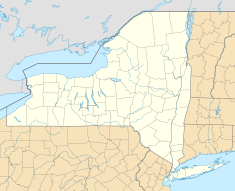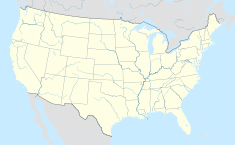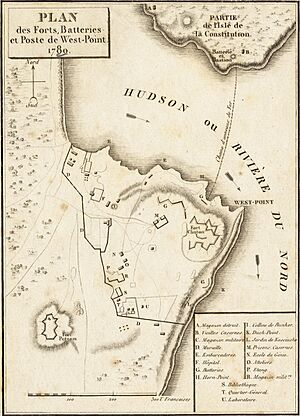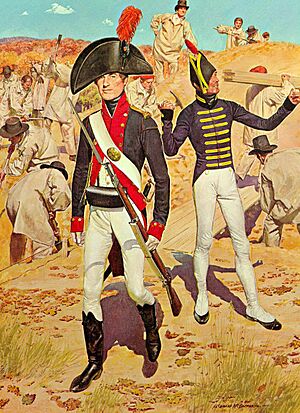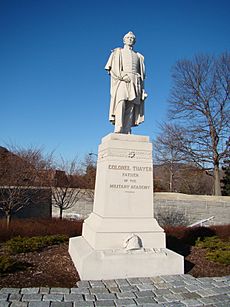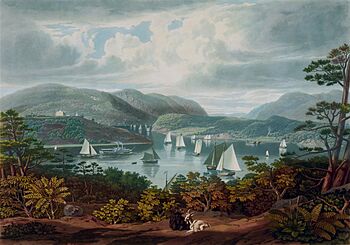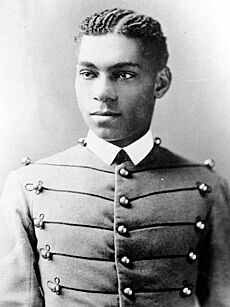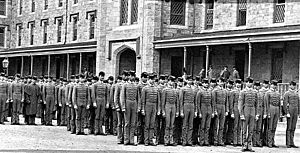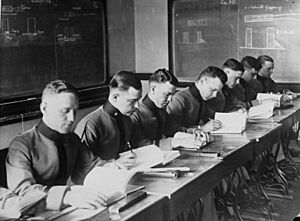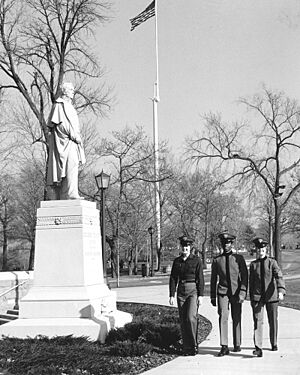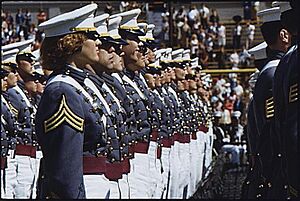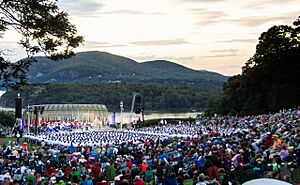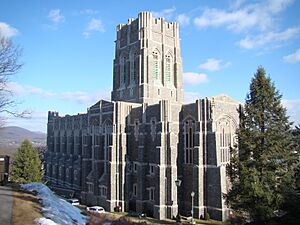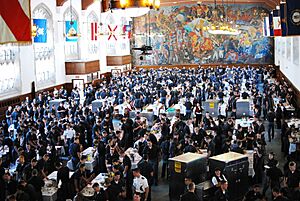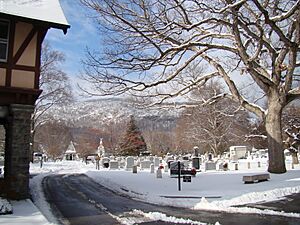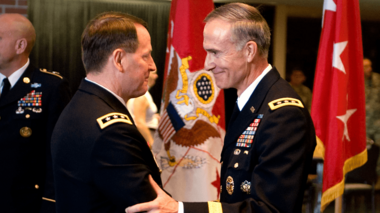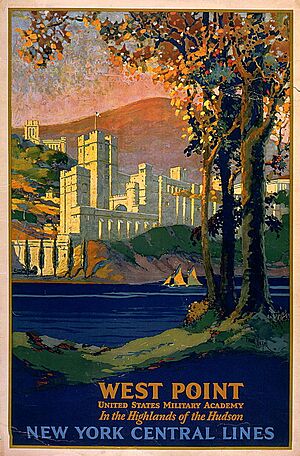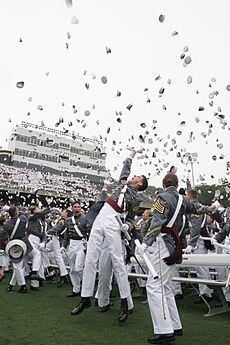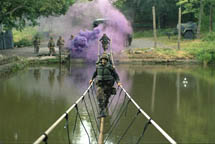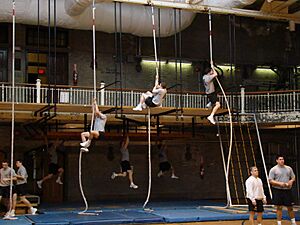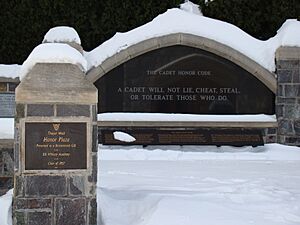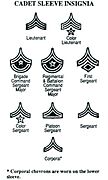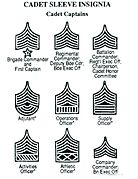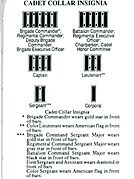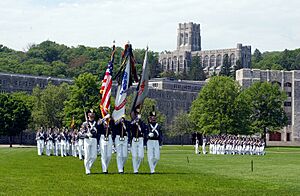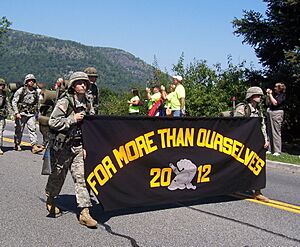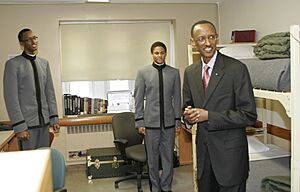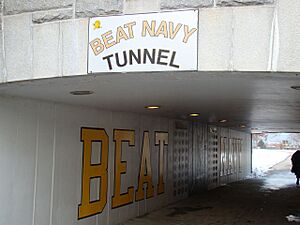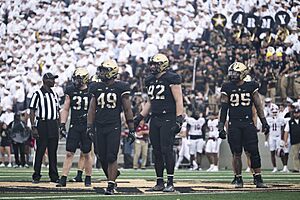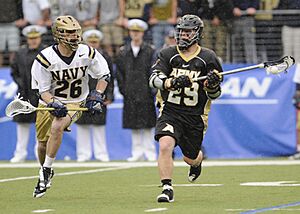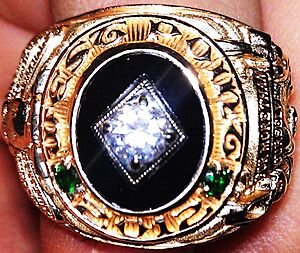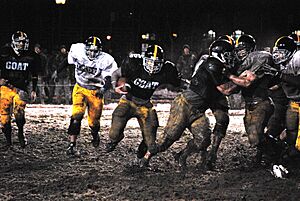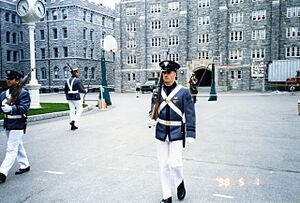United States Military Academy facts for kids
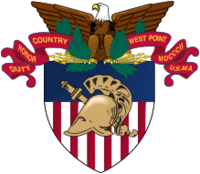 |
|
| Motto | Duty • Honor • Country |
|---|---|
| Type | U.S. Service Academy |
| Established | 16 March 1802 |
| Endowment | $422 million (2022) |
| Superintendent | Steven W. Gilland |
| Dean | Shane R. Reeves |
| Commandant of Cadets | R.J. Garcia |
|
Academic staff
|
580 |
| Students | 4,294 cadets |
| Location |
,
United States
|
| Campus | Rural – 16,080 acres (6,507.3 ha) |
| Fight song | On, Brave Old Army Team |
| Colors | Black, gold, and gray |
| Nickname | Black Knights |
|
Sporting affiliations
|
NCAA Division I – PL AHA CSFL EIGL EIWA NCA The American |
| Mascot | Mule |
|
United States Military Academy
|
|
| NRHP reference No. | 66000562 |
| Significant dates | |
| Added to NRHP | 15 October 1966 |
| Designated NHL | 19 December 1960 |
The United States Military Academy (USMA), often called West Point, is a special school in West Point, New York. It trains young people to become officers in the United States Army. Founded in 1802, it is the oldest of the five American service academies. The Army has used this location since 1780. It was a fort during the American Revolutionary War because it sits on high ground overlooking the Hudson River. This spot is about 50 miles (80 km) north of New York City.
West Point offers a Bachelor of Science degree. Students are graded on their schoolwork, leadership skills, and required sports participation. To get in, candidates must apply directly and usually need a nomination from a member of Congress. Students are called "cadets" and are officers-in-training. All cadets together are known as the "United States Corps of Cadets" (USCC). The Army pays for all tuition. In return, graduates must serve in the military after they finish school. About 1,300 cadets start each July, and around 1,000 graduate. West Point's long history and unique mission have influenced other schools. It was the first American college to have an accredited civil engineering program. Its technical courses became a model for other engineering schools. It was also the first college to have class rings.
West Point has 15 men's and nine women's sports teams that compete in the National Collegiate Athletic Association (NCAA). Cadets play one sport each season (fall, winter, spring). They can play at the intramural, club, or intercollegiate level. The football team was very strong in the early and mid-1900s, winning three national championships. West Point graduates are known as "The Long Gray Line." Famous alumni include U.S. presidents Dwight D. Eisenhower and Ulysses S. Grant. Other notable graduates are Confederate president Jefferson Davis, Confederate general Robert E. Lee, American poet Edgar Allan Poe, and U.S. generals Douglas MacArthur and George Patton. Many graduates have also become presidents of other countries. Seventy-six graduates have received the Medal of Honor.
Contents
West Point's History
Early Years and Founding
The Continental Army first arrived at West Point, New York, on January 27, 1778. It is the oldest Army post in the United States that has been used continuously. From 1778 to 1780, the Polish engineer Tadeusz Kościuszko helped build the fort's defenses. The Hudson River Chain and high ground helped the Army stop the British Navy from sailing upriver. This prevented the British from dividing American forces during the Revolutionary War. The fort was first called Fort Arnold, but after Benedict Arnold betrayed the American cause, its name was changed to Fort Clinton.
Training for "cadets" in artillery and engineering began at the fort in 1794. In 1801, President Thomas Jefferson decided to establish a military academy at West Point. He chose Jonathan Williams as its first leader. Congress officially approved the school on March 16, 1802. The academy opened on July 4, 1802. In its early years, there were few rules for who could join or how long they studied. Cadets ranged from 10 to 37 years old and attended for 6 months to 6 years. The upcoming War of 1812 led Congress to create a more formal education system and increase the number of cadets to 250.
In 1817, Colonel Sylvanus Thayer became the Superintendent. He created the school's curriculum, which is still used today. Thayer set strict rules for discipline and emphasized honorable behavior. He was inspired by the French École Polytechnique, where he had studied. Known as the "Father of the Military Academy," he has a monument on campus. West Point started as an engineering school. For the first 50 years, its graduates were famous for building many of the nation's first railways, bridges, and roads. It was the only engineering school in the country until 1824.
The Mexican–American War (1846-1848) made the academy famous. Graduates proved their skills in battle for the first time. Future Civil War commanders Ulysses S. Grant and Robert E. Lee (who later became West Point's superintendent) showed their bravery in Mexico. Many graduates received promotions or awards for their courage. The school modernized quickly in the 1850s. New buildings brought better heating and lighting. New training included modern rifle technology and steam engine advances.
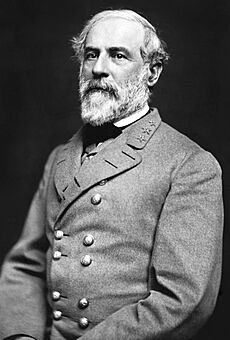
When the Civil War began, West Point graduates became generals for both the Union and Confederate armies. Nearly every important general from both sides was a West Point graduate. A West Point graduate led forces on one or both sides in every major battle of the war.
After the Civil War

After the Civil War, the academy became very famous because of its graduates' roles. However, it was a difficult time as the school worked to admit cadets from former Confederate states. The first black cadet, James Webster Smith, was admitted in 1870. He faced harsh treatment and was dismissed in 1874. Henry Ossian Flipper became the first black graduate in 1877. Two other famous graduates from this time were George Washington Goethals (1880), who engineered the Panama Canal, and John J. Pershing (1886), who led American forces in World War I.
After the war, hazing (harsh treatment of new students) became a problem. It became a national issue after a cadet's death in 1900. Congressional hearings investigated the issue. When Douglas MacArthur became superintendent, he tried to stop hazing by having Army sergeants train new cadets. Hazing continued in some ways but is no longer allowed today.
The demand for officers during the Spanish–American War and Philippine–American War caused classes to graduate early. This led Congress to increase the number of cadets to 481 in 1900. Many famous graduates came from West Point between 1900 and 1915, including Douglas MacArthur, George S. Patton, Dwight D. Eisenhower, and Omar Bradley. The class of 1915 is known as "the class the stars fell on" because so many of its members became generals.
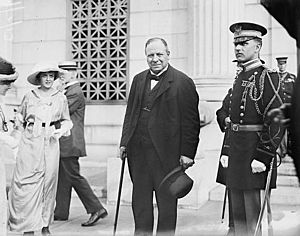
When America joined World War I, the need for officers increased sharply. The academy sped up graduations for all four classes. Douglas MacArthur became superintendent in 1919. He made big changes to the academic program, adding more history and humanities. He also improved field training. The Cadet Honor Committee was formed in 1922. West Point was first officially accredited in 1925. In 1933, it began giving Bachelor of Science degrees to all graduates.
World War II and Beyond
During World War II, Congress allowed more cadets, and classes graduated early again. West Point played a major role in WWII. Four of the five five-star generals were alumni. After the war, Maxwell Taylor (class of 1922) became superintendent. He expanded the academic program and removed old courses like fencing.
The Korean War did not change graduation schedules. More than half of the Army's leaders during the war were West Point graduates. The Class of 1950, which graduated just before the war, suffered many casualties. Garrison H. Davidson became superintendent in 1956. He improved admissions, added elective courses, and raised academic standards for instructors. In the 1960s, the number of cadets grew to 4,400.
West Point also felt the social changes of the Vietnam War era. The first woman joined the faculty in 1968. The academy found it hard to fill classes as its graduates led troops in Southeast Asia.
Modern Era
After the U.S. left Vietnam in 1973, more students wanted to attend West Point. On May 20, 1975, a law was passed to allow women into service academies. President Ford signed it on October 7, 1975.
West Point admitted its first 119 female cadets in 1976. In 1979, Cadet Vincent K. Brooks became the first African American to lead the Corps of Cadets. Ten years later, Kristin Baker became the first female First Captain, the highest-ranking senior cadet. Since then, six other women have been First Captain. Simone Askew was the first African American woman to hold this role. Today, women make up about 20% of new cadets.
In 1985, cadets were officially allowed to choose an academic major. Before this, all graduates received a general Bachelor of Science degree. In 1990, every cadet received a standard computer. The academy also started using the Internet in the mid-1990s.
During the Gulf War, alumnus General Norman Schwarzkopf led Allied Forces. Many American generals in Iraq and Afghanistan were also West Point graduates. After the September 11 attacks, applications to the academy increased greatly. Campus security was tightened, and the curriculum added courses on terrorism. In 2008, gender-neutral words were added to West Point's "Alma Mater" and "The Corps" songs. In December 2009, President Barack Obama gave a speech at West Point about sending more troops to Afghanistan.
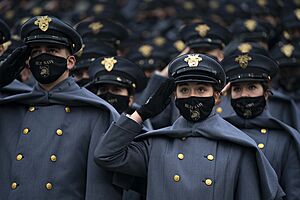
After the "Don't Ask, Don't Tell" policy was ended in 2011, the academy began admitting openly gay cadets. In 2016, the ban on transgender service members was lifted. The Class of 2017 included the first openly transgender graduate. In January 2016, Brig. Gen. Diana Holland became West Point's first woman Commandant of Cadets.
In 2020, the COVID-19 pandemic affected the campus. Classes had limits, and the traditional Army-Navy football game was moved to West Point to allow for social distancing. Army beat Navy 15–0 that year.
West Point Campus

The academy is about 50 miles (80 km) north of New York City. It is on the west bank of the Hudson River. The area is a federal military reservation in Orange County. Because of its importance in the Revolutionary War and as a military academy, most of the area was named a National Historic Landmark in 1960. Charles Dickens visited in 1841 and called it a beautiful and fitting place. Trophy Point is a popular spot with views of the Hudson River. It has cannons from past wars and the Stanford White-designed Battle Monument. The main academic area, called "central area" or "the cadet area," is easy to explore on foot.
In 1902, the architectural firm Cram, Goodhue, and Ferguson designed many buildings in the neogothic style. This style is still seen today, especially in the Cadet Chapel, finished in 1910. These buildings are mostly made of gray and black granite. Barracks built in the 1960s were designed to match this style. Older faculty homes are in the Federal, Georgian, or English Tudor styles. Some buildings, like Cullum Hall, are Neoclassical.
The academy grounds have many monuments and statues. The Plain, the main parade ground, has the most. These include monuments to George Washington, Sylvanus Thayer, Dwight D. Eisenhower, Douglas MacArthur, Tadeusz Kościuszko, and John Sedgwick. The Patton Monument was moved in 2009 to a temporary spot during construction. There is also a statue from the French École Polytechnique near Nininger Hall. The rest of the campus has 27 other monuments.
The West Point Cemetery is where many famous graduates and faculty are buried. These include George Armstrong Custer, Winfield Scott, and William Westmoreland. Eighteen Medal of Honor recipients are also buried there. Many recent graduates who died in Iraq and Afghanistan are buried here too. Some older graves have large, fancy markers. The cemetery also has a monument to Revolutionary War heroine Margaret Corbin.
Athletic Facilities
West Point has historic sports facilities like Michie Stadium and Gillis Field House. It also has modern ones like the Lichtenberg Tennis Center. Michie Stadium recently got major upgrades for the football team. A new artificial turf field was installed in 2008.
West Point Museum
The visitor center is just outside the Thayer Gate in Highland Falls. You can arrange guided tours there. These tours are the only way the public can visit the academy grounds. The new Malek West Point Visitors Center opened in 2016. It is named after Frederic Malek, a West Point graduate.
The West Point Museum is next to the visitor center. It is in the renovated Olmsted Hall. Opened in 1854, it is the oldest military museum in the country. In summer, the museum offers access to Fort Putnam and Constitution Island. Some famous items on display include George Washington's pistols, Napoleon's sword, and a dagger carried by Hermann Göring. A gold-plated pistol that belonged to Adolf Hitler is also on display.
How West Point is Run
Academy Leadership
The leader of West Point is called the Superintendent. This role is like a president of a civilian university. Recently, the superintendent has been a lieutenant general (a three-star general). Lieutenant General Steven W. Gilland became the 61st Superintendent on June 27, 2022. The Superintendent reports directly to the Army Chief of Staff.
There are two other general officers at the academy. Brigadier General R.J. Garcia is the Commandant of Cadets, like a dean of students. Brigadier General Shane Reeves is the Dean of the Academic Board, like a provost. Brigadier General Diana Holland was the first female commandant. Brigadier General Jebb was the first female Dean. West Point has 13 academic departments, each led by a colonel. These colonels make up the Academic Board. The academy is also watched over by the Board of Visitors (BOV). This group of Senators, Congressional Representatives, and presidential appointees checks on the academy's morale, curriculum, and other matters.
How to Get In
Candidates must be between 17 and 23 years old, unmarried, and have no children they are legally required to support. Good high school grades and strong scores on tests like the SAT are expected. Most admitted students are in the top fifth of their high school class.
To be accepted, candidates must also pass a fitness test and a full physical exam. Up to 60 students from other countries can attend West Point. Their home countries pay for their education. One Filipino cadet is specifically allowed by law.
The application process has two main parts: applying to West Point and getting a nomination. Most candidates get a nomination from their U.S. Representative or Senator. Some get a nomination from the Vice President or President.
Getting into West Point is competitive. For the Class of 2024, about 7.74% of applicants were admitted. Candidates with previous college experience must still start as a fourth-class cadet and complete the full four-year program. Some candidates who are not selected may be offered a chance to attend the United States Military Academy Preparatory School. If they do well there, they can then be appointed to the academy.
Research Centers
The academy has many research centers, including:
- Army Cyber Institute
- Combating Terrorism Center
- Center for Data Analysis and Statistics
- Center for Holocaust and Genocide Studies
- Center for Innovation and Engineering
- Center for Languages, Cultures, and Regional Studies
- Center for Leadership and Diversity in STEM
- Center for Oral History
- Cyber Research Center
- Digital History Center
- Modern War Institute
- Robotics Research Center
- West Point Leadership Center
West Point's Curriculum
West Point is a four-year college with no graduate programs. It focuses on arts, sciences, and military training. There are 45 academic majors. The most popular are foreign languages, management information systems, history, economics, and mechanical engineering. West Point is accredited by the Middle States Commission on Higher Education. Most of the teachers (75%) are military officers.
A cadet's class rank affects their Army job after graduation. This rank is based on school performance (55%), military leadership (30%), and physical fitness and sports (15%).
Academics
The academy uses the Thayer method of teaching. This means small classes with daily homework. Students are expected to do their homework before class and discuss it together.
The academic program has 31 required courses in arts and sciences. Cadets choose their majors in the spring of their first year. But all cadets take the same courses until their second year. These core courses include math, information technology, chemistry, physics, engineering, history, geography, philosophy, leadership, psychology, English, foreign language, political science, international relations, economics, and constitutional law. All cadets graduate with a Bachelor of Science degree.
Military Training
All cadets become second lieutenants when they graduate. So, military and leadership education is a big part of their studies. Military training is overseen by the Commandant of Cadets. New students, called fourth-class cadets, start on Reception Day (R-day). This begins cadet basic training (CBT), also known as Beast Barracks. Many cadets find Beast to be the hardest part of their time at West Point. It helps them change from civilian to military life.
In their second summer, cadets do cadet field training (CFT) at Camp Buckner. Here, they learn more advanced military skills. In their third summer, cadets can be instructors for CBT or CFT. Senior cadets also train at Camp Buckner to prepare for their roles as new platoon leaders. Cadets can also train with active Army units around the world during their summers. They can also attend special military schools like Airborne or Air Assault.
Active duty officers, usually captains or majors, serve as Company Tactical Officers (TAC Officers). They guide, train, and teach cadets about discipline and being good role models. Each cadet company has one TAC Officer and a senior Non-Commissioned Officer to help.
The Department of Military Instruction (DMI) teaches all military arts and sciences. It also plans and runs summer training. DMI has representatives from each Army branch. These "branch reps" help cadets prepare for their future Army jobs. The Modern War Institute, a research center, is also part of DMI.
Physical Fitness
The Department of Physical Education (DPE) manages the physical program. This includes physical education classes, fitness tests, and sports. The head of DPE is called the Master of the Sword, a title from the 1800s when sword fighting was taught.
All cadets take required fitness classes like military movement (gymnastics), boxing, survival swimming, and advanced combatives. They can also choose classes like scuba or rock climbing.
Like all soldiers, cadets must pass the Army Physical Fitness Test twice a year. They also must pass the Indoor Obstacle Course Test (IOCT) every year. This test has been given in Hayes Gymnasium since 1944.
Since Douglas MacArthur was superintendent, every cadet must play an intercollegiate sport, a club sport, or an intramural sport each semester.
Moral and Ethical Training
Cadets learn about morals and ethics throughout their time at West Point. They live under the honor code and participate in leadership programs. They learn about military values, attend religious programs, and interact with staff and faculty role models. The core of West Point's ethical code is its motto: "Duty, Honor, Country."
West Point's Cadet Honor Code states: "A cadet will not lie, cheat, steal, or tolerate those who do." If cadets are accused of breaking the Honor Code, they go through an investigation. If found guilty by other cadets, they can face serious consequences, like repeating a year or being removed from the academy.
The honor code is famous and has influenced many other colleges. However, the academy has had some major violations. For example, in 1976, 151 junior cadets were found guilty of cheating on exams. In 2020, more than 70 cadets were also accused of cheating.
Cadet Life
Ranks and Organization
Cadets are not called freshmen, sophomores, juniors, or seniors. Instead, they are officially called fourth class, third class, second class, and first class cadets. Informally, freshmen are plebes, sophomores are yearlings or yuks, juniors are cows, and seniors are firsties. The term plebe comes from "plebeians," the lower class in ancient Rome. Yearling means a year-old animal. The term cow might come from cadets having no leave until their yearling year. When they returned as second-class cadets, it was like "the cows coming home."
The Corps of Cadets is organized like a brigade. The highest-ranking cadet, the Brigade Commander, is called the First Captain. The brigade has four regiments. Each regiment has three battalions, and each battalion has three companies. Companies are named A through I, with a number for their regiment (e.g., H1, H2, H3, H4). First-class cadets hold leadership roles, from First Captain down to platoon leaders. Leadership duties decrease for lower classes. Second-class cadets are cadet sergeants, third-class cadets are cadet corporals, and fourth-class cadets are cadet privates.
Daily Life
Cadets come from all 50 U.S. states and territories. The academy also has up to 60 international exchange cadets. Cadets attend West Point for free. The Army pays for all tuition and housing. In return, graduates must serve five years of active duty and three years in the reserves.
Most graduates become second lieutenants in the Army. Foreign cadets join their home countries' armies. Since 1959, cadets can also choose to join other armed services. Cadets receive a monthly payment for books, uniforms, and other needs. Money is automatically taken out for expenses. Any money left is for the cadet to use. All cadets eat meals in the dining halls and have internet access on school-issued devices. In the 2016–2017 school year, there were 4,389 cadets. About 20% of the students are female.
All cadets live on campus for all four years in one of nine barracks buildings. Most rooms have two cadets, but some have three. Cadets are grouped into "companies" by codes. All companies live in the same barracks area. The commandant might have cadets change companies sometimes. All 4,000 cadets eat breakfast and lunch together in Washington Hall on weekdays. The cadet fitness center, Arvin Cadet Physical Development Center, has many facilities for students.
Each class of cadets elects leaders like a class president. They also choose a ring and crest committee. This committee designs the class's crest, which is on their class rings. Each class crest must have "USMA" and their class motto. The class motto is chosen during basic training. Class mottos often rhyme with their class year.
Cadets follow the West Point Leader Development System (WPLDS). This system outlines the roles cadets play during their four years. Cadets start as trainees (new cadets). They then move up in rank, from CDT Privates (freshmen) to CDT Officers (seniors). Freshmen have no leadership roles but learn to follow orders. Seniors have important leadership duties and more privileges.
Activities
Cadets have many extracurricular activities. The Directorate of Cadet Activities (DCA) runs 113 athletic and non-sport clubs. Many cadets join several clubs. These clubs offer a break from the tough cadet life. DCA also runs three cadet restaurants, the Cadet Store, and publishes The Howitzer (the yearbook) and Bugle Notes. Bugle Notes, also called the "plebe bible," is a manual of traditions, songs, poems, and facts about the academy. Plebes must memorize this information during basic training. They can be asked about it by older cadets.
Each cadet class has at least one special "class weekend" each year. Fourth-class cadets have Plebe Parent Weekend in the spring. Third-class cadets celebrate Yearling Winter Weekend in February. In late January, second-class cadets celebrate 500th Night, marking 500 days until graduation. First-class cadets have three formal events: Ring Weekend in early fall, 100th Night in February, and a week of events leading to graduation in May. All "class weekends" include a formal dinner and dance, called a "hop." Grant Hall, once the cadet mess hall, is now a social center. Cadets can also participate in programs like the Peace & Dialogue Leadership Initiative.
Athletics
Since 1899, Army's mascot has been a mule. This animal symbolizes strength and never giving up. The football team was called "The Black Knights of the Hudson" because of their black uniforms. This name is now shortened to "Black Knights." Sports media often just say "Army" for the academy. "On Brave Old Army Team" is the school's fight song. Army's main sports rival is the Naval Academy. This is due to their long-standing football rivalry and the general rivalry between the Army and Navy. New cadets greet older cadets and faculty with "Beat Navy." A tunnel under Washington Road is even named the "Beat Navy" tunnel. Army also plays the U.S. Air Force Academy for the Commander-in-Chief's Trophy.
Football
Army football started in 1890 when Navy challenged the cadets to a game. Navy won that first game, but Army won the next year. The two academies still play each December. This is usually the last regular-season college football game. Navy had a 14-game winning streak against Army, but Army won 21–17 in 2016. Army's football team was most successful under coach Earl Blaik. They won national championships in 1944, 1945, and 1946. Three Army players won the Heisman Trophy: Doc Blanchard (1945), Glenn Davis (1946), and Pete Dawkins (1958). Famous NFL coaches Vince Lombardi and Bill Parcells were early Army assistant coaches. The football team plays home games at Michie Stadium. The field is named after Earl Blaik. Cadets must attend football games and stand for the whole game. At home games, one of the four regiments marches onto the field before the team.
Other Sports
West Point has a long history in other NCAA sports besides football. Army is part of the Division I Patriot League for most sports. Its men's ice hockey team plays in Atlantic Hockey. John P. Riley Jr. coached hockey at West Point for over 35 years. Every year, Army plays the Royal Military College of Canada (RMC) Paladins in a hockey game. This series started in 1923.
The men's lacrosse team has won eight national championships. The 2005–06 women's basketball team won the Patriot League tournament. They went to the 2006 NCAA Women's Division I Basketball Tournament as a 15th-ranked team. This was the first time any Army basketball team went to the March Madness tournament. The coach of that team, Maggie Dixon, passed away shortly after the season at age 28. Bob Knight, a very successful men's basketball coach, started his career at Army in the 1960s. One of his players at Army was Mike Krzyzewski, who later coached Army and then Duke, winning five national championships.
About 15% of cadets are on a club sport team. West Point has 24 club sports teams. They have won national championships in judo, boxing, orienteering, pistol, triathlon, crew, cycling, and team handball.
Most students (about 65%) play intramural sports, called "company athletics" at the academy. The DPE's Competitive Sports committee runs these programs. In the fall, they compete in basketball, flag-football, team handball, soccer, ultimate disc, and wrestling. In the spring, they compete in combative grappling, floor hockey, orienteering, flicker ball, and swimming. Each company also enters a team in the annual Sandhurst Competition, a military skills event.
West Point Traditions
West Point has many old and special traditions because of its age and mission. Here are some unique traditions.
Cullum Number
The Cullum number is a special ID number given to each graduate. It was created by Major General George Washington Cullum (Class of 1833). In 1850, he started writing biographies of every graduate. He gave number one to the first graduate, Joseph Gardner Swift, and then numbered all others in order. Graduates are listed by their class year. Former cadets who attended but did not graduate also get Cullum numbers, but in a different way.
Class Ring
West Point started the college tradition of the class ring with the class of 1835. Before 1917, cadets could design much of their ring. Now, only the center stone can be personalized. One side of the ring has the academy crest. The other side has the class crest. The center stone has the words West Point and the class year. The academy library has a large collection of cadet rings on display. Senior cadets get their rings during Ring Weekend in the early fall of their senior year. After receiving their rings, freshmen gather around seniors from their company. They ask to touch the ring. After reciting a poem called the Ring Poop, the senior usually lets the freshmen touch the ring. Since 2002, old class rings are melted down. Some of the gold is mixed with gold from previous melts to make new rings for each senior class.
Thayer Award
West Point gives out the Sylvanus Thayer Award every year since 1958. This award honors an outstanding citizen whose service and achievements show the academy's motto: "Duty, Honor, Country." The person receiving the award cannot be a West Point graduate. Many famous Americans have received this award, including George H. W. Bush, Colin Powell, Sandra Day O'Connor, Henry Kissinger, Ronald Reagan, and Condoleezza Rice.
Sedgwick's Spurs
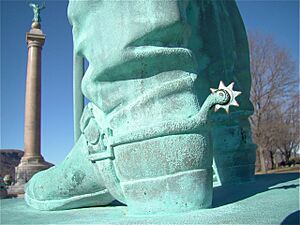
A statue of Civil War Union General John Sedgwick stands near the Plain. Sedgwick's bronze statue has spurs that spin freely. A legend says that if a cadet is about to fail a class, they should wear their full-dress uniform the night before the final exam. The cadet visits the statue and spins the spurs at midnight. Then, the cadet runs back to the barracks as fast as possible. The legend says if Sedgwick's ghost catches them, they will fail. Otherwise, they will pass the exam and the course.
Goat-Engineer Game
Before the Navy football game, the Corps of Cadets plays the Goat-Engineer game. This game started in 1907. It is played between the "Goats" (the lower half of the senior class academically) and the "Engineers" (the top half). They play with pads and helmets using eight-man football rules. The game's location has changed over the years. Legend says that if the Goats win, Army will beat Navy. If the Engineers win, Army will lose. In recent years, female cadets also play a flag football game.
Walking the Area
Since the academy's early days, one punishment for breaking rules has been "punishment tours." Cadets call this "hours" because they must walk for a certain number of hours as punishment. Cadets get hours based on how serious their mistake was. Being late to class might mean 2 hours, while more serious issues could mean 60 to 80 hours. Cadets wear their dress gray uniform and walk back and forth in a special area of the barracks courtyard, called "Central Area." Cadets who often get in trouble and spend many weekends "walking off their hours" are called "area birds." Cadets who walk more than 100 total hours are called "Century Men." Sometimes, instead of walking, cadets can do "fatigue tours," which means manual labor like cleaning. Cadets whose grades are low might do "sitting tours." They study in a special room and get half credit for their hours. Cadets' uniforms are checked before tours. A small number of cadets might be excused if their uniforms are perfect. Another tradition is that any visiting head of state can grant "amnesty," which means all cadets with outstanding hours are released from their punishment.
Sandhurst Military Skills Competition
In 1967, the Royal Military Academy Sandhurst gave West Point a British Army officer's sword. This sword became a trophy for a military skills competition at West Point. In 2019, the Sandhurst competition lasted two days. Teams from West Point, ROTC programs, and other U.S. service academies competed. International academies from the UK, Canada, Australia, and Ireland have also won this competition.
Schools for Dependents
The Department of Defense Education Activity (DoDEA) runs West Point Elementary School and West Point Middle School on the academy grounds. These schools are for children of military personnel.
High school students who are dependents of on-base military personnel attend James I. O'Neill High School in Highland Falls. West Point pays for their education there.
Rankings
The U.S. Military Academy at West Point is considered a liberal arts college by U.S. News. It was ranked #8 among National Liberal Arts Colleges in the 2025 edition of Best Colleges.
Preparatory School
The U.S. Military Academy Preparatory School, or USMAPS, helps prepare soldiers and civilians for West Point. It was officially started in 1946. The school helps students develop the academic, leadership, and physical skills needed to succeed as cadets.
Famous Alumni
A saying at West Point is, "Much of the history we teach was made by people we taught." Graduates call themselves "The Long Gray Line." The academy has produced almost 65,000 alumni. This includes two U.S. Presidents: Ulysses S. Grant and Dwight D. Eisenhower. It also includes the president of the Confederate States of America, Jefferson Davis. Four foreign heads of state or government have also graduated from West Point.
Military Leaders
West Point has graduated many famous leaders since 1802. During the Civil War, a West Point graduate led one or both armies in every major battle. These included Ulysses S. Grant, George McClellan, William Tecumseh Sherman, Stonewall Jackson, and Robert E. Lee. George Armstrong Custer graduated last in his class in 1861.
During World War I, alumni included General John J. Pershing. Many notable World War II generals were West Point alumni, such as Henry H. Arnold, Omar Bradley, Douglas MacArthur, and George S. Patton. Many of these graduates also led forces in the Korean War. During the Vietnam War, famous general officers included Creighton Abrams and William Westmoreland. West Point also produced recent famous generals and leaders like Norman Schwarzkopf, Jr., David Petraeus, and Lloyd Austin.
A total of 76 graduates have received the Medal of Honor. West Point has also graduated 18 NASA astronauts, including five who went to the moon.
Business Leaders
West Point has become known for producing successful business leaders. Famous alumni include:
- Jim Kimsey, who founded AOL.
- Bob McDonald, former CEO of Procter & Gamble.
- Alex Gorsky, CEO of Johnson & Johnson.
- Keith McLoughlin, President and CEO of Electrolux.
- Alden Partridge, who founded Norwich University.
Sports Figures
Contributions to sports include three Heisman Trophy winners: Glenn Davis, Doc Blanchard, and Pete Dawkins. Abner Doubleday, sometimes thought to have created baseball, graduated from West Point in 1842.
Government Officials
West Point alumni include many important government officials. These include Brent Scowcroft, who was the National Security Advisor for two presidents. Eric Shinseki was the former Secretary of Veterans Affairs. West Point graduate Frank Medina helped lead the campaign to give the Congressional Gold Medal to the 65th Infantry Regiment.
Among American universities, West Point is fifth for total Rhodes Scholarships, seventh for Marshall Scholarships, and fourth for Hertz Fellowships. The official alumni group is the West Point Association of Graduates (WPAOG).
West Point Garrison and Stewart Army Subpost
West Point is an active U.S. Army base. Several regular Army units support the academy and the base. The U.S. Army Garrison includes a Headquarters Company, Military Police, Religious Program Support, Keller Army Community Hospital, and the USMA Band. The USMA Band is a regular Army band; cadets are not members.
The 1st Battalion, 1st Infantry Regiment (1–1 INF) and the 2d Army Aviation Detachment are stationed at nearby Stewart Army Subpost. They provide military training and aviation support to West Point. The 10th Mountain Division from Fort Drum, NY, also sometimes provides support.
See also
 In Spanish: Academia Militar de los Estados Unidos para niños
In Spanish: Academia Militar de los Estados Unidos para niños
- United States service academies
- U.S. Air Force Academy (USAFA)
- U.S. Coast Guard Academy (USCGA)
- U.S. Merchant Marine Academy (USMMA)
- U.S. Military Academy (USMA; Army)
- U.S. Naval Academy (USNA)
- United States Military Academy grounds and facilities
- List of monuments at the United States Military Academy
- Kosciuszko's Garden
- Army University
- Redoubt Four (West Point)
- West Point Cadets' Sword
- West Point Band
- The Jazz Knights


